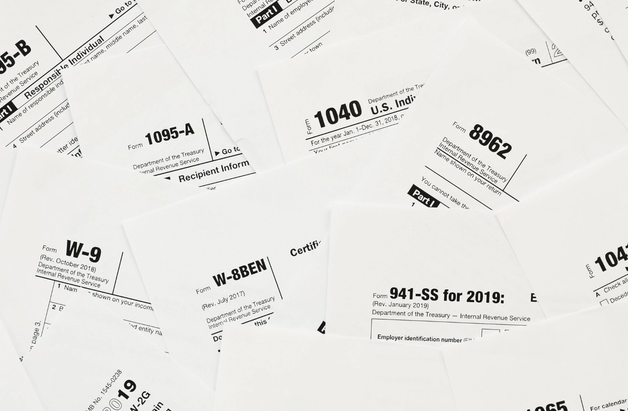How To Spot a Fake 1099 Form & What to Do About It?

October 30, 2023
Anyone can fall victim to tax fraud, such as using falsified 1099 forms. That said, learning how to spot a fake 1099 form and other tax forms can be a lifesaver for everyone—businesses, independent contractors, and regular taxpayers alike.
Falsified 1099 forms are subject to serious penalties and consequences, including civil penalties and criminal charges.
So, if you don’t want to compromise your employment or operations, this article provides a step-by-step guide on how to identify fake 1099 forms and the countermeasures you can take in case you receive fake tax documents.
Key Takeaways
- To spot a fake 1099, focus on checking the accuracy of all information reported in each 1099 form. Check that each document has consistent and professional formatting.
- Scammers use fraudulent 1099 forms to secure loans, attempt to receive a higher tax refund, or qualify for specific government benefits such as unemployment and medical assistance.
- Among the possible legal consequences of using fake 1099 forms are civil penalties, criminal charges, and a damaged reputation.
Why & When Are 1099 Forms Needed?

IRS 1099 forms are needed to report income and payments received from companies and persons who are not the recipient’s employer. Some 1099 forms are also used to report health insurance coverage payments and income generated through investments.
There are several types of 1099 forms, each with a specific purpose:
- 1099-A, Acquisition or Abandonment of Secured Property. This form is used to report property and capital losses. An example is when an individual loses their property due to a foreclosure.
- 1099-B, Proceeds From Broker and Barter Exchange Transactions. It reports both gains and losses resulting from the sale of stocks, bonds, or other types of securities at a barter exchange or brokerage.
- 1099-C, Cancellation of Debt. This 1099 form is used to negotiate the cancellation or forgiveness of debts with a lender. Examples of debts where 1099-C may be used are property foreclosures, and then debts are written off on credit card accounts.
- 1099-DIV, Dividends & Distributions. The 1099-DIV reports all income generated from distributions, such as brokerage accounts and investment dividends.
- 1099-G, Certain Government Payments. A few examples of certain government payments reported in Form 1099-G include state or local income tax refunds, unemployment compensation, and taxable grants.
- 1099-H, Health Coverage Tax Credit (HCTC). This IRS form records advance payments meant to compensate specific and qualified health insurance coverage.
- 1099-K, Payment Card & Third-Party Network Transactions. This form reports income received via third-party payment processing platforms, such as Paypal, Stripe, Venmo, or Amazon Pay.
- 1099-MISC, Miscellaneous Information. The 1099-MISC is used to report certain types of miscellaneous income or payments. These payments may come in the form of rental payments, crop insurance proceeds, or gross proceed payments to attorneys, to name a few.
- 1099-NEC, Nonemployee Compensation. The 1099-NEC replaced the 1099-MISC in documenting all payments to self-employed individuals, freelancers, and independent contractors.
All recipients of 1099 forms use the documents to file their tax returns and check their tax liabilities.
How to Spot a Fake 1099 Form
To spot a fake 1099 form, pay attention to the following telltale indicators:
Incorrect Name, Address, and TIN
Real 1099 forms bear the recipient’s correctly spelled name, an accurate tax identification number, and a complete address.
The payee information declared on the 1099 form must also match the details on the official documents attached to the form. Otherwise, inconsistencies in the spelling, numbers, and address are typical signs of a falsified 1099 form.
Questionable Income Amounts
Scammers who falsify 1099-NEC, 1099-MISC, and 1099-K often exaggerate the amount they input for their income and received payments.
Compare the values declared in the form with the income received and the amount indicated in the payer’s records. The values should match up to the last cent, and if not, investigate the validity of the documents further.
Unexpected Benefits
If you received unexpected benefits such as unemployment compensation even without filing a Form 1099-G, for instance, there is a high probability that you have fallen victim to a form of IRS scam.
It is possible that a scammer used your personal information to file fraudulent 1099 forms. Remember, you cannot claim any type of refund on your taxes unless you file the correct IRS form and back up your claim with the required documents.
Inconsistent Formatting
IRS forms are official documents issued by the federal government. The documents contain consistent and organized formatting. Also, the forms must be printed on premium-grade paper.
Sloppy-looking 1099 forms are likely falsified and must, therefore, be reported to the authorities.
Insufficient Copies
Real 1099 forms also have three to four copies. One copy goes to the state tax department, at least two typically go to the recipients, and one is sent to the IRS.
Count the number of 1099 forms. If the sender of the form is incapable of providing the required number of copies and has no valid explanation to back it up, then it is possible that you have spotted a fake 1099.
5 Reasons For Creating a Fake 1099 Form
Although illegal and subject to serious consequences, some people still resort to creating fake 1099 forms for the following reasons:
- Falsify income. Often, people who create a fake 1099 to secure an apartment or loan do not earn enough income to meet the minimum requirements needed to qualify for their desired loan amount or rent.
- Claim unemployment compensation. Fraudsters may trick unsuspecting victims into divulging their personal information and tax and employment data, then use the stolen information to file false unemployment claims.
- Claim medical relief. Claiming medical relief can either be a form of scam or a way for individual taxpayers to claim medical services, particularly when they are faced with a financial or health-related emergency.
- Expand refundable tax credits. Scams involving refundable tax credits grew rampant during the COVID-19 pandemic. Some taxpayers try to maximize the amount of tax credits they can refund because it potentially means receiving more money back from the IRS.
- Execute tax scams. One of the most rampant tax scams these days is called the “Miscellaneous Income” scheme, where scammers pose as banks or large financial institutions. Next, they offer the fake 1099-MISC to their victims as an option they can use to repay their outstanding bank loans and credit card debts.
Legal Consequences of Using Fake 1099 Forms

Can you fake a 1099 form? Unfortunately, yes, you can—but not without facing serious legal consequences, especially when you get caught.
The legal consequences and penalties for filing a false 1099 may vary depending on the severity of the offense.
Civil Penalties
Civil penalties include interest and charges to individuals and businesses spotted faking 1099 forms. The penalties will depend on the amount of time and the circumstances involving the fabrication of the IRS forms.
For instance, if a business is proven to have submitted IRS forms with unverified and incorrect information intentionally, they may have to pay fines amounting to at least $50 to $3,339,000 per form.
Criminal Charges
Individuals and businesses willfully falsifying 1099 forms to evade their taxes and intentionally commit fraud are subject to imprisonment, on top of paying fees and interests.
Loss of Credibility
Businesses associated with fraudulent practices, such as the use and distribution of fake 1099 forms, inevitably lose their credibility and damage their reputation.
Sadly, even though some businesses did not mean to commit errors in reporting and filing 1099 forms, the mistake can still cost them the trust of their partners and clients, especially when the issue is not resolved immediately.
More Stringent Auditing and Investigation
The IRS keeps a closer and stricter eye on entities or businesses proven to have had a hand in fabricating 1099 forms.
Whether the scams and errors in 1099 forms are intentional or not, the IRS willscrutinize and audit all income and returns reported by a taxpayer or group with a questionable tax history.
Other government offices involved in monitoring taxpayer compliance in filing and paying their taxes may even take part and prevent the scams from taking place again.
How Fake 1099 Forms Negatively Impact Banks
Fake 1099 forms negatively impact banks, especially when borrowers submit fabricated 1099s and W-2s as proof of income.
Banks require loan applicants to present pay stubs and other valid documents to verify their earnings and show they have sufficient income to repay their desired loan amount.
As such, if a bank or financial institution does not know how to properly spot a fake 1099 or scrutinize the debtor’s financial documents, they may end up facing penalties, criminal charges, as well as losing customer trust.
It is crucial for banks and institutions that primarily deal with money to establish and maintain a high level of credibility to convince more individuals and organizations to do business with them.
How to Protect Yourself From Fake 1099 Forms as an Individual
Aside from knowing all the steps on how to spot a fake 1099, there are also ways to stay protected against fake 1099 schemes and similar forms of fraud:
Double-check All the Information on the Forms
It is crucial to review all the information reported on each of these forms, particularly if you want to spot a fake 1099 early on. Check every single detail—from thenameand tax identification number to the address and income amounts and the documents’ format.
Missing the smallest details on 1099 forms is easy, but it is also the small mistakes that can lead to serious legal action and penalties when overlooked.
Identify the Different IRS Scams
Get familiarized with the different types of IRS and tax fraud.
Scammers usually target 1099-NEC, 1099-MISC, 1099-G, and 1099-H forms because these documents are used to report income, miscellaneous payments, health insurance coverage, and claim tax refunds.
Scammers also pretend to be agents from government offices. They contact their victims and trick them into believing they owe the government a massive amount of tax or have errors in their tax records.
Use a 1099 Form Generator
Technically, using a 1099 form generator benefits both individuals and companies. Online generators for tax forms are legitimate and acceptable ways to speed up the process it takes to furnish these important IRS documents.
Most generators come with ready-made templates that stay true to the original format provided by the IRS. You can prepare as many 1099 forms as needed and save electronic copies that you can also use if you register for the IRS’ e-filing program.
Report Any Detected Fraud
Once you see mistakes or questionable details on your 1099 form, contact the company or business that sent the forms. If possible, clarify and resolve these errors before submitting them to the IRS.
If the business, institution, or client who sent the fraudulent 1099 forms refuses to cooperate, seek assistance from the IRS.
What Should a Company Do if They Receive a Fake 1099 Form?

The following are the possible countermeasures that companies can take in case they receive a fake 1099 form:
Provide Sufficient Guidance & Training
Train and educate employees on how to spot fake 1099 forms and other tax documents.
Teach them how to fill out each type of form correctly and provide all the possible action they can take in case they detect falsified IRS forms. Do the same with contractors hired for their services.
Verify Your Contractor’s Background
Check all the documents and information submitted by each independent contractor or freelancer you hire to fulfill a job. Ideally, this is a step that companies must take before moving forward with doing business with any independent contractor.
However, it is possible that spotting fake 1099 forms can get past the initial background check. If there are errors or falsified details on the forms, contact the contractor immediately.
Audit Records Regularly
Make it a habit to check all 1099 documents and related records. Cross-reference each form and ensure that they all bear accurate and correct information.
Report any 1099 form with questionable details and sloppy or unprofessional formatting to the proper authorities.
Final Thoughts
The lack of background in identifying fake 1099 forms can prove risky for individual taxpayers and businesses.
From a regular taxpayer’s perspective, it could mean facing mountains of fees and debt, while for businesses, falsified IRS forms could leave a permanent dent in their credibility and operations.
That said, knowing how to spot a fake 1099 and stop all tax-related scams from taking place is one of the best ways to steer clear of serious legal trouble in the future.
How to Spot a Fake 1099 Form FAQ
#1. What are the penalties for filing an incorrect 1099 form?
The penalties for filing an incorrect 1099 form cost $50 to $290 per form. For small businesses, penalties can amount to as much as $1,113,000, while for large businesses, they can go as high as $3,339,000.
#2. Can I be liable if someone else files a fake 1099 on my behalf?
Unfortunately, yes, you can be held liable even if someone else files a fake 1099 on your behalf. As such, it is crucial to double-check and ensure that you report the correct tax and income on your 1099 forms.
#3. Can you fix an incorrect 1099 form after filing?
Yes, you can fix an incorrect 1099 form after filing. To do this, file and send a copy of the corrected 1099 form to the recipient. Make sure to check the ‘CORRECTED’ box. Next, file a paper copy of Red Copy A of Form 1096 and mail it to the IRS.
#4. What can I do about fraudulent 1099 forms?
If you receive fraudulent 1099 forms, you can contact the business or person who sent the fake documents. Otherwise, report the fake 1099 forms to the IRS if the sender refuses to cooperate.


